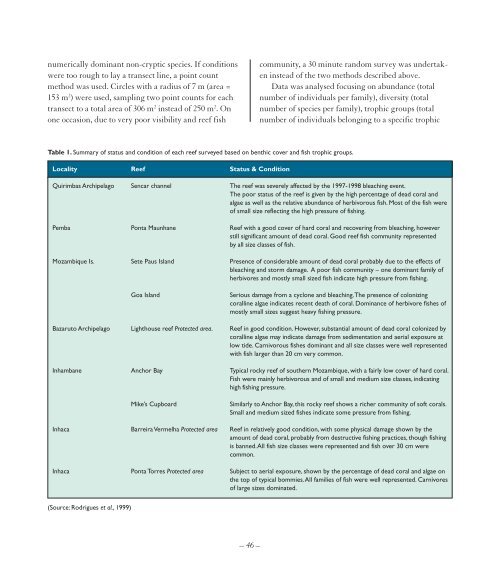Create successful ePaper yourself
Turn your PDF publications into a flip-book with our unique Google optimized e-Paper software.
numerically dominant non-cryptic species. If conditions<br />
were too rough to lay a transect line, a point count<br />
method was used. Circles with a radius of 7 m (area =<br />
153 m 2 ) were used, sampling two point counts for each<br />
transect to a total area of 306 m 2 instead of 250 m 2 . On<br />
one occasion, due to very poor visibility and reef fish<br />
community, a 30 minute random survey was undertaken<br />
instead of the two methods described above.<br />
Data was analysed focusing on abundance (total<br />
number of individuals per family), diversity (total<br />
number of species per family), trophic groups (total<br />
number of individuals belonging to a specific trophic<br />
Table 1. Summary of status and condition of each reef surveyed based on benthic cover and fish trophic groups.<br />
Locality Reef <strong>Status</strong> & Condition<br />
Quirimbas Archipelago Sencar channel The reef was severely affected by the 1997-1998 bleaching event.<br />
The poor status of the reef is given by the high percentage of dead coral and<br />
algae as well as the relative abundance of herbivorous fish. Most of the fish were<br />
of small size reflecting the high pressure of fishing.<br />
Pemba Ponta Maunhane Reef with a good cover of hard coral and recovering from bleaching, however<br />
still significant amount of dead coral. Good reef fish community represented<br />
by all size classes of fish.<br />
Mozambique Is. Sete Paus Island Presence of considerable amount of dead coral probably due to the effects of<br />
bleaching and storm damage. A poor fish community – one dominant family of<br />
herbivores and mostly small sized fish indicate high pressure from fishing.<br />
Goa Island<br />
Serious damage from a cyclone and bleaching. The presence of colonizing<br />
coralline algae indicates recent death of coral. Dominance of herbivore fishes of<br />
mostly small sizes suggest heavy fishing pressure.<br />
Bazaruto Archipelago Lighthouse reef Protected area. Reef in good condition. However, substantial amount of dead coral colonized by<br />
coralline algae may indicate damage from sedimentation and aerial exposure at<br />
low tide. Carnivorous fishes dominant and all size classes were well represented<br />
with fish larger than 20 cm very common.<br />
Inhambane Anchor Bay Typical rocky reef of southern Mozambique, with a fairly low cover of hard coral.<br />
Fish were mainly herbivorous and of small and medium size classes, indicating<br />
high fishing pressure.<br />
Mike’s Cupboard<br />
Similarly to Anchor Bay, this rocky reef shows a richer community of soft corals.<br />
Small and medium sized fishes indicate some pressure from fishing.<br />
Inhaca Barreira Vermelha Protected area Reef in relatively good condition, with some physical damage shown by the<br />
amount of dead coral, probably from destructive fishing practices, though fishing<br />
is banned. All fish size classes were represented and fish over 30 cm were<br />
common.<br />
Inhaca Ponta Torres Protected area Subject to aerial exposure, shown by the percentage of dead coral and algae on<br />
the top of typical bommies. All families of fish were well represented. Carnivores<br />
of large sizes dominated.<br />
(Source: Rodrigues et al., 1999)<br />
– 46 –


















